The foodservice industry is a lucrative sector when several factors, including a tasty menu, functional commercial dining seating, and smooth service, are combined duly to create an optimal food-serving establishment. The quality and taste of the foods should naturally be the primary concern for any entrepreneur to sustain their business. However, aiming at retaining the best taste in food preparation but leaving out the other details may result in lower traffic and declining sales.
Commercial dining seating is one of the decisive factors in the success of any business, along with furnishing the facility with the right commercial kitchen equipment; and presenting a premium service. Restaurant and coffee shop seating, hence, should be carefully planned and realized to match the restaurant seating strategy for achieving business goals.
Why is Commercial Dining Seating Important?
- As stated by the study titled “Exploring Factors on Customers’ Restaurant Choice: An Analysis of Restaurant Attributes” in the British Food Journal, the appearance and decoration of a foodservice business are closely related to customer satisfaction which deeply affects the return of customers’ for a second time.
- The ambiance of a restaurant affects the expectations and experience of the customers.
- Creating a visually appealing atmosphere and design for your target group positively correlates with the customer turnover in your café or restaurant.
- Paying more attention to the design and selection of the commercial dining seating will also help you build a brand for your business by displaying a consistent show of atmosphere and interior design.
- A good-chosen commercial dining seating will provide a relaxing time for your customers during their meal.
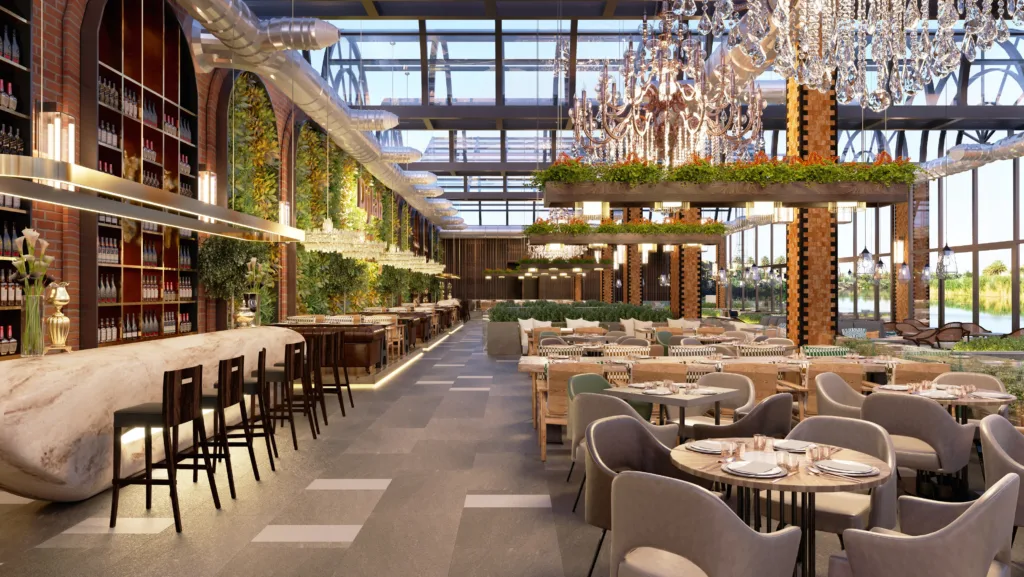
Things to Consider When Choose Commercial Dining Seating
It would help if you kept in mind that maintaining customers sitting and turning them into regulars require overall satisfaction. The restaurant dining room layout poses a remarkable significance here since:
After deciding on the location and establishment of your business and finalizing the menu, you can continue to look for the right foodservice furniture that will suit your needs and conditions at the best level to create the most efficient restaurant seating layout.
1. Determining the Layout
Regulations
The official regulations must be the first thing you should check when starting to create your restaurant layout and getting the commercial dining seating. These rules conclude the maximum occupant load for cafes, bars, and restaurants and specify the minimum area that must be allotted per customer. Despite the varying values, the average area per customer should be at least 15 square feet for the food service businesses.
Business Type
The type of the business is also a factor that must be considered while the layout organization is considered. While 15 sq. feet of space is enough for regular full-service restaurant dining and 11 sq. feet for fast food stores, you should raise this area to about 20 sq. feet for the fine dining restaurants.
Available Space
When determining the commercial dining seating for your business, you should also take the available space in your business into consideration. Even though profitability requires the maximum use of space, a crowded atmosphere, and congested layout will deteriorate the customer experience.
2. Theme
Commercial dining seating is a visible part of a remarkable restaurant ambiance, a crucial part of the brand image, high-end customer experience. Hence, if you want to create an atmosphere with the overwhelming features of rustic, farmhouse, modern, or vibrant styles, you should also select the commercial chairs and tables accordingly to complement the overall decoration.
In addition, creating a fine dining restaurant is not limited to elegantly decorated plates. You should also pay attention to creating an exquisite restaurant and café decoration with upscale restaurant seating tables and chairs with premium materials and a more airy atmosphere. For instance, you can start turning to the upholstered vintage restaurant seating types rather than investing in plastic and plain chairs.
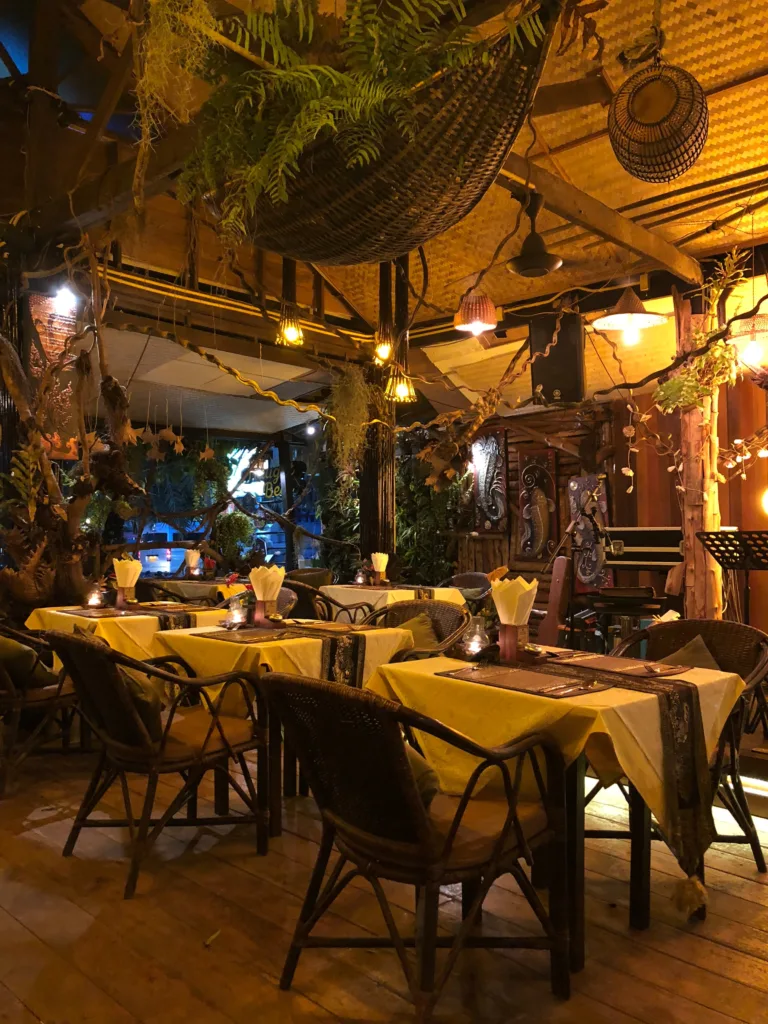
3. Budget
The success of any foodservice business is directly related to smart budget controls; whether you start a restaurant or café from scratch or only renew the existing one, you should carefully decide each spending to catch up with all the costs.

Commercial dining seating will consume a remarkable share of your budget since even a small business needs to get around 10 tables and about 40 chairs, depending on the size of the facility. This may force you to incline towards the cheaper options, but this can cost you more in the long run with maintenance costs. Hence, you are recommended to make a smart selection to balance the cost and durability to minimize the overall cost of the restaurant furniture supplies by opting for commercial-rated products with sturdy construction.
4. Cleaning and Maintenance
Cleaning and sanitation are vital factors that every foodservice business must pay close attention to, particularly after a global pandemic that caused the shutdown of foodservice industry for months; sanitizing the serviceware and cleaning the facility and the furniture is of great importance to prevent any cross-contamination that may harm the public health as well as damaging the reputation of well-performing food service business.
So, it would be best if you chose easy-to-clean commercial dining seating units to accelerate the removal the stains and debris and to quickly prepare for the next customer. Hence, you should select a smoother surface that can be wiped off efficiently and decorated with straight lines. This will let your staff clean the tables and chairs efficiently rather than elaborately ornated options that have many deep places where the food debris and dust can accumulate/pile up.
5. Versatility and Practicality
Versatility is the key word that will help you lower your costs in running a foodservice business since it enables you to use commercial kitchen equipment and restaurant supplies for different purposes. You can also extend this term to commercial dining seating by, for instance, choosing restaurant dining tables and chairs which are suitable for both indoor and outdoor use. Or, you can have easily paintable chairs and tables that can be modified to fit your decoration even after a change.
Commercial dining seating may sometimes need to be reorganized, or there occur some occasions when you need more seating for a crowded event. Here, the easy-to-store stackable chairs and mobile tables will be of great use by minimizing the space occupied for storage.
6. Accessibility and Safety
Commercial dining seating should be formed to address the needs of every group of customers, including those with disabilities. The Americans with Disabilities Act (ADA) provides a clear guide for the foodservice businesses to make their facility ADA-accessible. Additionally, each state has its own regulations for ADA accessibility. For instance, when you serve with more than 20 tables, you need at least 1 ADA-compliant table and seating in Michigan.
The distance between tables in a restaurant should be adjusted to open the way for wheelchairs, which will also allow your personnel to move freely around during service without causing any danger to the customers while carrying hot foods or drinks, for instance.
7. Keep Consumer Experience & Expectations in Mind
Consumer expectation is very influential on their decision to come to your restaurant, and when they visit your establishment, they will evaluate the experience they had with the design, comfort, menu, prices, and service. If these all match their expectations or you promise them to realize, they will become regulars, recommend you to their friends, and leave positive reviews for your restaurant.
When you are planning the commercial dining seating, you need to guess/detect the possible expectations of your future customers and create the best reflection of these expectations in your establishment. If you want to establish a fast food restaurant with a high customer circulation, it is best to use cheaper chairs with easier cleaning.
However, when you want to create a high-end, expensive fine dining restaurant, you must allocate more budget for commercial dining seating. You can get cushioned seats with back support that will maximize the comfort of your guests and extend their time in your facility, increasing the amount they spend.
Elements and Types of Commercial Dining Seating
As the styles and concepts vary in the food serving industry, so do the restaurant seating types. Restaurant seating layout can be organized to improve customer satisfaction by providing the proper furniture that will advance the customer experience.
1. Tables
You mostly choose the restaurant dining tables with seating options together, so we think it would be good to mention them here. They are available in various that normally accommodate 2, 4, or 6 people at a time. While cafes and fast-food restaurants with limited space generally have 2-and 4-seat capacity tables, high-capacity restaurants prefer to have 6-seater tables. Commercial dining tables can also be pushed together to form more seating capacity to accommodate crowded parties.
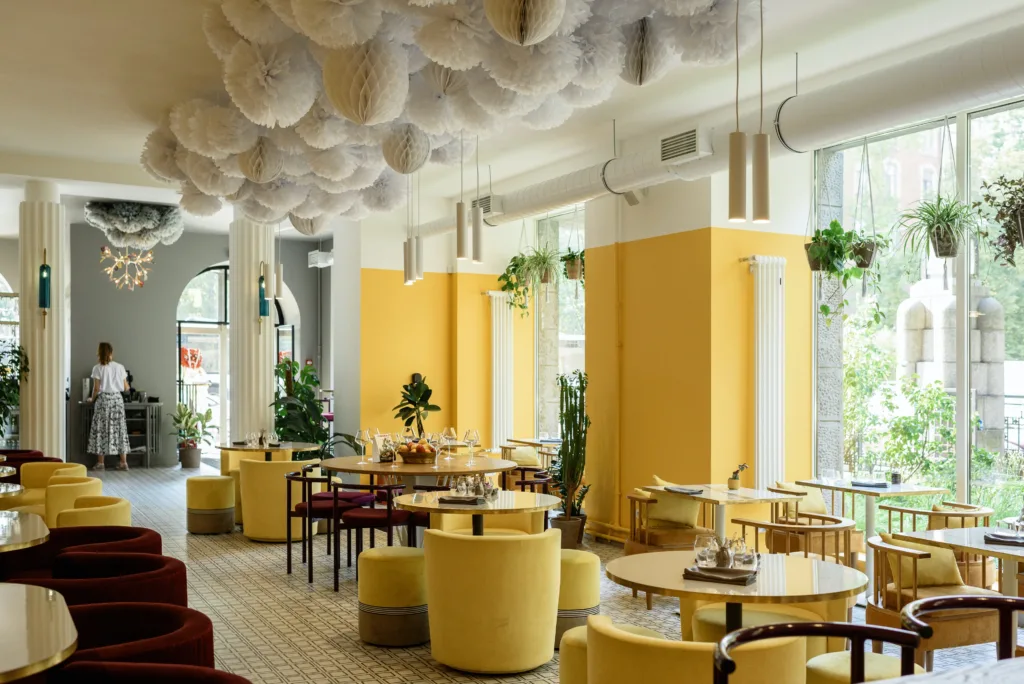
Table Top Shapes
Tables for commercial dining seating can be found mainly in three models: Round, Square, and Rectangular.
- Round: Commercial round-top tables are perfect to create a more intimate atmosphere to let your customers enjoy a sincere conversation with their friends. Even though these units are hard to place next to the walls, they can accommodate more chairs and seat more people by occupying less space. Hence, these are perfect for getting the most out of the limited space.
- Square: Providing enough space for up to 4 people, square tables allow your patrons to stay closed when they eat or chat. Additionally, these units can be used to create a larger seating area by moving next to each other.
- Rectangular: These commercial tables can hold up to 6 people despite creating larger/longer distances from each other.
Table Top Material
Commercial tables are manufactured from wood, laminate, resin, stone, granite, or wood, and they generally have smooth surfaces for easier cleaning. While solid wood, granite, and stone tabletops present a premium appearance, laminate and melamine/resin options are lower-priced options for casual restaurants.
2. Restaurant Seating
Choosing and arranging commercial dining seating is of great importance with its direct relation to customer satisfaction and profitability. Here you also have various options to create the best atmosphere for your business.
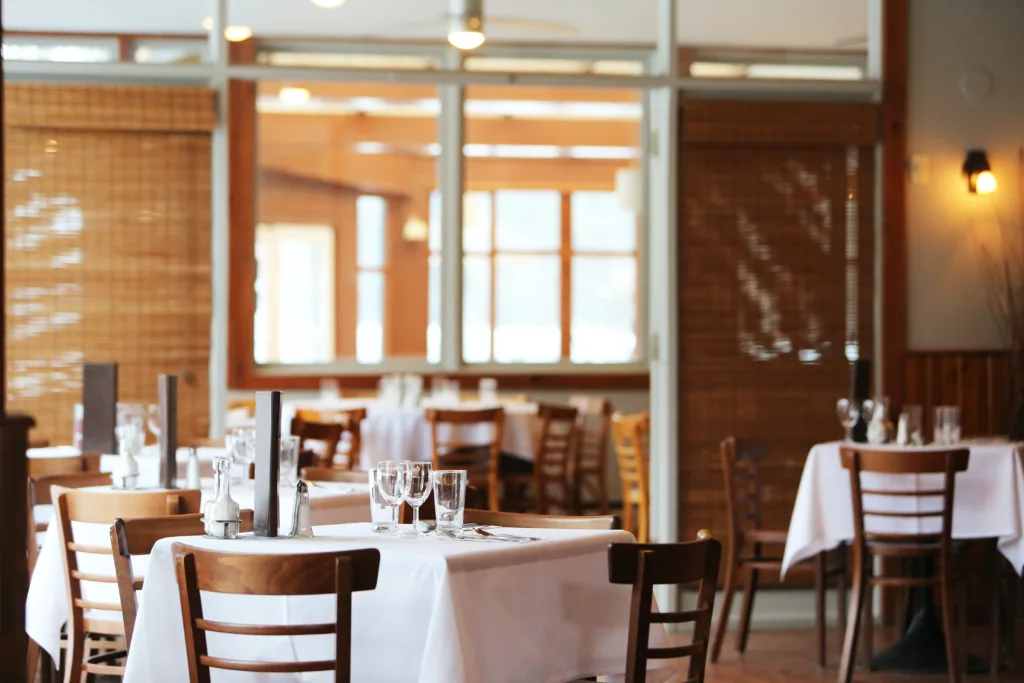
Restaurant Chairs
Café and restaurant dining room chairs are one of the most common commercial dining seats, and many businesses prefer to arrange their layout with different models.
- Material: Restaurant chairs are primarily produced from wood or metal. Wooden restaurant chairs present an upscale look with elegant designs and a sleek finish and are better for high-end restaurants. Metal restaurant chairs are generally lower priced but more durable, thereby lowering the overall cost for fast-food restaurants.
- Seat Size: Commercial dining seating chairs are available in different sizes ranging from 15 to 21 inches wide. While narrow chairs are more suitable for limited spaces, wider chairs are more comfortable to encourage your customers to spend more time in your facility.
- Seat Comfort: One of the most important factors that you should consider is the comfort of the restaurant chairs in your establishment. Upholstered cushioned seats, padded back, and arm supports will certainly enhance customer comfort if you want your customers to prolong their time in your restaurant.
Restaurant Booths
Classic and modern restaurant booth seating is an iconic feature of restaurants and cafes. Presenting a merged seat, restaurant booths are suitable for family use to keep their children next to the parents. Additionally, they are generally padded and upholstered with easy-clean fabric that enhances comfort and facilitates cleaning.
You can also find the curved booths, which can be placed in the corners to create a U-shaped seating which will increase the seating capacity while providing more privacy for customers to enjoy their time with their families.
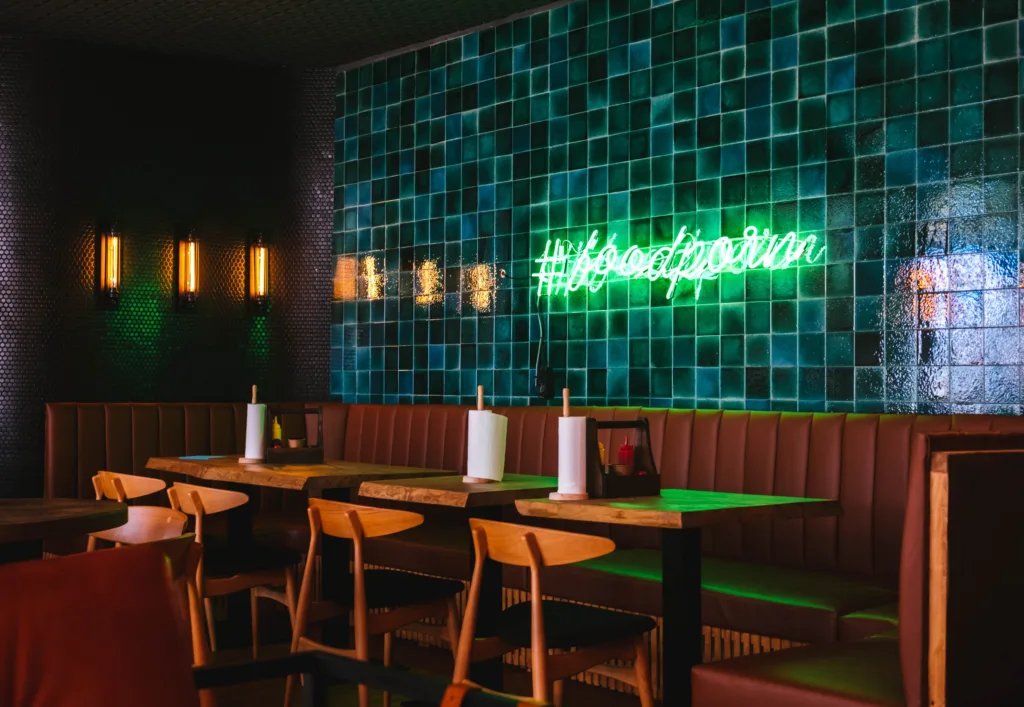
Bar Stools
Bar stools are nice-looking commercial dining seating options, creating a spacious atmosphere. Additionally, these high-top seating units will help you save space by utilizing the bar counter and wall counters to open space for more tables in the middle. Restaurant bar tools can be found with stationery or swivel bases, and you can choose between wooden or metal models.
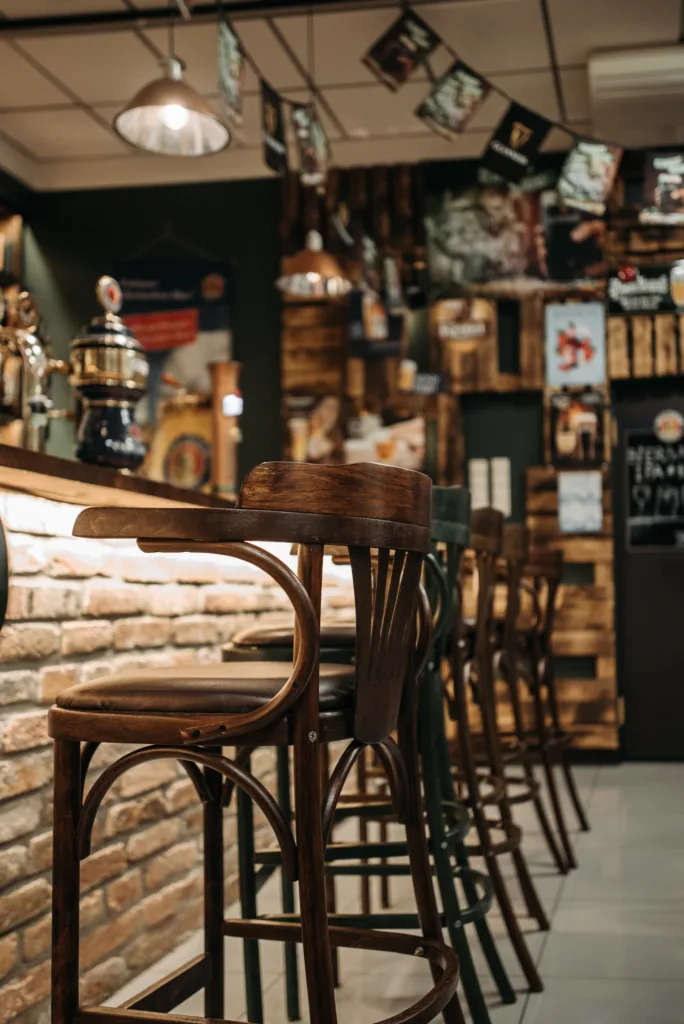
Booster Seats and High Chairs
Families are also a significant group that you should attract to your restaurant or café. Hence, you are recommended to develop your commercial dining seating with booster seats and high chairs to elevate children to the table while maintaining their safety.
Conclusion for Commercial Dining Seating
The commercial dining seating is one of the top things every business owner must allot time to plan, procure, organize, and improve. Customer satisfaction is crucial for the success of any foodservice business, and you should develop a comprehensive/wholesome approach to the customer experience to reach the highest customer satisfaction. It would also be best to consider material, capacity, and comfortable options in your commercial dining seating purchase process, as well as considering budget, layout options, versatility, cleaning, and safety.

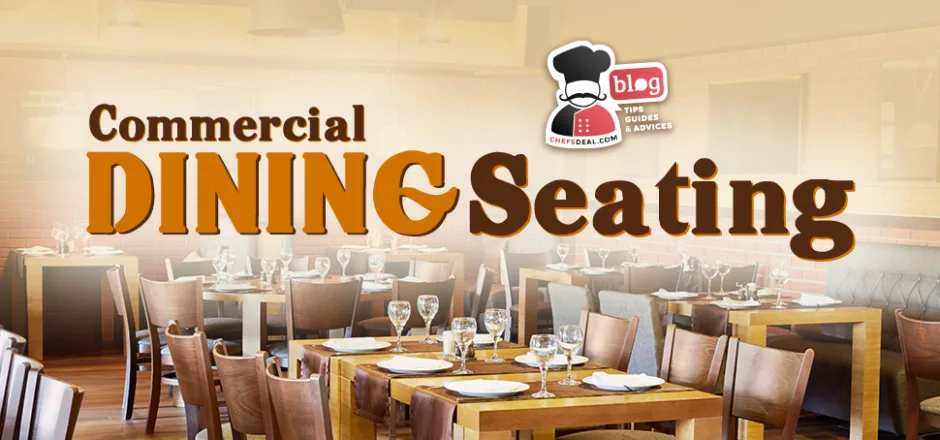


2 comments On 7 Considerations for Choosing Commercial Dining Seating
Selecting the right commercial dining seating is pivotal for any restaurant’s success. Comfort, durability, and aesthetics all play crucial roles. This blog provides valuable insights for restaurateurs looking to create a welcoming and stylish dining atmosphere for their customers. Well done!
Definitely agreed! Thank you, Louis.